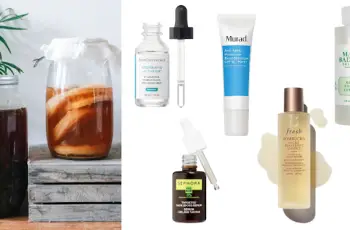
Can salicylic acid and glycolic acid be used together?
If you know anything about skin care, you already know how these two powerful ingredients work on the skin and what benefits you can expect. However, the question we ask ourselves is: Can salicylic acid and glycolic acid be used together? Let’s explore this in more detail and learn more about how to benefit most effectively from this skin-rejuvenating duo.
In the next section, you will get a quick overview of how these ingredients work on the skin. Once you know what glycolic acid and salicylic acid are, you can move on to the next section.
What is glycolic acid?
Derived from sugar cane, glycolic acid is one of the most commonly used alpha hydroxy acids (AHAs). This effective chemical exfoliant is often included in many skin care formulas to remove the layer of dead skin cells on the surface of the skin. Signs of aging such as fine lines and wrinkles are visibly reduced, hyperpigmentation and dark spots are minimized, blemishes and spots appear less frequently, and skin appears clearer.
Once the layer of dead skin cells is removed, you will notice a noticeable change in the overall appearance of your complexion and the health of your skin. If you want to learn more about glycolic acid and its benefits, read our dedicated blog post.
What is salicylic acid?
People often think that salicylic acid works similarly to glycolic acid, but they are actually cousins rather than siblings. The main difference between these acids is that salicylic acid is oil-soluble, which means it can penetrate deep into the pores. It can remove dirt, deposits, and excess sebum from the pores. When the pores become clogged with these impurities, you’ll find your skin is covered in blemishes such as blackheads and pimples. Those with oily skin and prone to frequent rashes will benefit the most from salicylic acid.
Because its molecular size is significantly smaller than other acids, it can penetrate deeper, which means that people with dry and sensitive skin may experience severe dryness and irritation. Therefore, we always recommend consulting your doctor or primary care provider to ensure that you are using the best ingredients for your skin. In addition, you can also do a 24-hour patch test to check if adding salicylic acid to your skincare routine is beneficial.
If you want to learn more about salicylic acid, read our dedicated blog post on smart BHAs.
Now that we have a quick summary, let’s get straight to more information about these acids and their uses.
Can glycolic acid be mixed with salicylic acid?
You can certainly use glycolic acid and salicylic acid together, but we recommend not mixing them. This is because a combination of such strong ingredients can cause a severe reaction in the skin and can damage the skin barrier. Once the skin’s protective barrier is compromised, you’ll find it more vulnerable to free radical damage, such as from UV rays, pollution, central heating and other environmental aggressors.
You can effectively combine them by alternating the phases of your skin care routine. If you wait at least 10 minutes between applications to allow the pH of your skin to balance and stabilize, you can avoid unnecessary irritation.
Can salicylic acid and glycolic acid be used on the same day?
Yes, you can, but as I suggested, you need to give your skin enough time to prepare for the next application. Some people find that the best way to use glycolic acid and salicylic acid on the same day is to use a cleanser or exfoliating toner with glycolic acid in the morning and then a salicylic acid serum in the evening.
This works for many people because the toner with glycolic acid clears the surface of dead skin cells, leaving the skin fully receptive to the next steps in the routine. By using salicylic acid at night, its effects won’t be interfered with by other free radicals, such as UV rays and pollution. When you wake up, you’ll notice a refreshed, radiant complexion with clear, receptive skin. Just apply SPF 30 or above daily to protect against UV damage.
Can I use salicylic acid in the morning and glycolic acid at night?
Of course, as I mentioned in the previous section, alternating the ingredients is an easy way to benefit from the properties of each acid. Although I described in the previous section that using salicylic acid at night is less problematic, many people find that using it in the morning works best for their routine. Using salicylic acid in the morning is especially helpful for oily skin because the BHA can penetrate deep into the pores and help regulate sebum production. This means that skin stays matte longer and makeup stays in place.
Whichever method works for you, just make sure you use the right ingredients and the best formula for you and your skin. Just because a product works wonders for a friend, doesn’t mean it will work for you, too. Pay close attention to how your skin reacts.
Can I use two products with salicylic acid?
Not really. Too many products with salicylic acid can cause unnecessary skin irritation. This is because a few percentages of the powerful BHA are too harsh for the skin. Even people with oily skin or a tolerance to salicylic acid can experience redness, rashes and increased sensitivity.
For more information on what not to use salicylic acid with, see the previous blog post where everything is explained in more detail.
There you will find more details on using salicylic and glycolic acid together. If you have any further questions, don’t forget to find us on Instagram.


